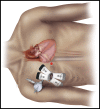Minimally Invasive Mitral Valve Surgery II: Surgical Technique and Postoperative Management
- PMID: 27654406
- PMCID: PMC5051532
- DOI: 10.1097/IMI.0000000000000300
Minimally Invasive Mitral Valve Surgery II: Surgical Technique and Postoperative Management
Abstract
Techniques for minimally invasive mitral valve repair and replacement continue to evolve. This expert opinion, the second of a 3-part series, outlines current best practices for nonrobotic, minimally invasive mitral valve procedures, and for postoperative care after minimally invasive mitral valve surgery.
Figures








References
-
- Youssef SJ, Millan JA, Youssef GM, Earnheart A, Lehr EJ, Barnhart GR. The role of computed tomography angiography in patients undergoing evaluation for minimally invasive cardiac surgery: an early program experience. Innovations. 2015;10:33–38. - PubMed
-
- Rodriguez R, Gojkovic O, Khitri A, et al. Totally endoscopic minimally invasive mitral valve surgery as a routine approach: a 10 year experience. Mitral Conclave American Association for Thoracic Surgery, Sheraton Towers, New York, NY USA, May 5–6, 2011.
Publication types
MeSH terms
LinkOut - more resources
Full Text Sources
Other Literature Sources
Medical

